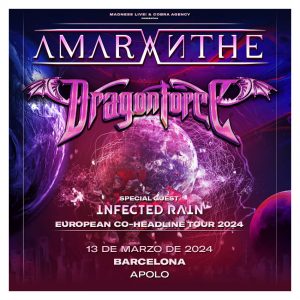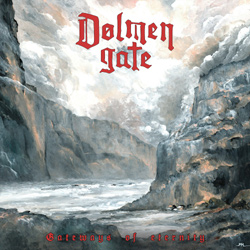HEAD OF THE DEMON (EN)
– Hello, thanks for taking the time. How is everything going right now with HEAD OF THE DEMON? What’s keeping you busy at the moment?
All is well and going in the right direction I’d say. For now it is rehearsals for an upcoming gig that will be our main focus. And playing around with some new material and songs. As well as waiting for the LP version to come in about a months time.
– First off, why did you decide to name the band «Head of the Demon»? Which is the literal translation of the word ‘ra’s al-ghūl’.
I initially used the word Alghoul as a working moniker. But I wanted something that wasn’t as plain as that so I used the literal translation of the word, as you point out. Besides that, I think using the term Head of the Demon somewhat signals that we are not your average “Occult Doom Metal” band or whatnot. It gives us a freedom to act outside of genre specific patterns. Which has been very important to us from the start.
– Earlier this year you released your sophomore album, «Sathanas Trismegistos». Are you pleased with how it turned out?
Yes we are extremely pleased with it.
– Starting to dwell into this new album, what does it’s title represent? Is it a reference to Hermes? Even though doesn’t seem to be much Hermeticism on the album.
The title is inspired by Hermes Trismegistos and used in a LHP context as mentioned. It is a very personal take on certain topics within the Draconian/Typhonian tradition. And one could say my personal take on the entities, Satan, Lucifer and The Devil. The title, besides being an epithet, encloses very well what the album is dealing with and is about. And true, the Hermetic school is not overly represented on our album. Yet its maxim “As above, so below” is something that pretty much all occult schools adhere to. And in one regard one could say that its idea is somewhat expressed in the song Nox Est Lvx.
– Hermes was the Thrice Great. Would then the album title represent some kind of threefold Satan?
Yes.
– I think with the overall atmosphere you manage to build throughout the whole album you somehow manage to convey the essence of that entity. It isn’t a horrific nor always dark album, it also has smooth, gentle and full of light moments
Very glad to hear that. And yeah, Satan has many faces and qualities.
– Could you say your music and HEAD OF THE DEMON is some kind of vessel? What is the band and your music to you?
Yes, I would very much like to think so. The band has served a function of containing the flow of inspiration from the demon star Alghoul. And for me it is a creative and artistic vessel that I can direct my inspiration towards.
– On the album there’s other entities too, as Armilus, an anti-messiah figure in Jewish escathology. What could you comment on using this figure on the song «Armilus Rides… Again!»?
Armilus is not an entity per se but rather the name of a anti messianic figure in Judaism, prior to Christianity being a religion. So one can compare him to an Anti-Christ figure. Just like Nero, Djengis Khan and some other figures has served to do. The song yielded itself when it comes to lyrical theme and topic. I just simply followed the inspiration and ended up there.
– The lyrics on this album seem to be mostly based upon the Left Hand Path current. Is it based on your personal experiences?
Yes, one could say that. But one reads too much into the lyrics if one believes them to be renditions of just personal experiences. It includes that, but also personal thoughts and ideas that have been the result of magical practice.
– In fact you are a member of the Dragon Rouge. How much of your devotion to the Draconian traditions have you brought to this musical creation?
100%.
 – Lyrics are an important part of the album and say a lot about the music, but aren’t the focus in a sense that the lyrics start and end with the music; rather they breath and have their own space, just like another instrument in unison with the rest. How is your approach to lyrics?
– Lyrics are an important part of the album and say a lot about the music, but aren’t the focus in a sense that the lyrics start and end with the music; rather they breath and have their own space, just like another instrument in unison with the rest. How is your approach to lyrics?
My approach with lyrics in Head of the Demon is that they need to fill a specific purpose in connection to the music. We write the material to be foremost instrumental. So when adding lyrics they need to serve the same purpose as if another instrument would be included. And if they don’t add to the song, then there is no reason to not keep it instrumental. Also, from an artistic view, if you know from the start that there will be a lyric that includes a chorus, bridge, verses etc, then you arrange the song in that manner. We simply don’t want to use that blueprint even though it has some benefits.
– There quite rough tunes such as «Maleficum», which seems to be more related to sorcery. What could you comment on this particular song?
The lyrical theme of the song and its aim is a curse. Other than that I won’t dwell on it.
– Of course occultism is a strong inspiration for you, but what figures specifically? Also authors such as HP Lovecraft have been kind of an influence. What other authors have you drawn inspiration from?
Not really figures, but rather topics within the LHP. It is hard to narrow down authors in particular. But some would be Lovecraft, Crowley, Poe, Milton, Sheridan Le Fanu, etc…
– In fact your debut album as strongly inspired by Lovecraft. It’s curious in a band that basically deals with true devotion and real practices, since Lovecraft opuses were myths, anyway authors such as Kenneth Grant for instance believed he was actually psychically inspired by those entities he wrote about…
I don’t think it is contradictory at all. Many people and cultures use different names for the same powers. And occasionally there is literature that is highly influenced and based on occult topics, for example Dennis Wheatley. Even if the authors don’t adhere to what they write about, they can still do it greatly and admirably.
– The cover artwork it’s quite symbolic. If I’m not mistaken comes from an old edition of the Divina Comedia, looks more like an «Inferno» part. How did you find this piece and why did you decide to use it? Seems to fit the album quite good.
The drummer found it on the net initially and showed it to me. I imedietely considered it as a front cover. But it would of course need some alterations from its original. We hunted it down and simple used it. And yeah, it is from a Divina Comeda edition and it certainly fits the album perfectly.
– The album sound is really organic and with that singular live vibe. Would you mind to tell us how was the recording process?
The album was recorded live and instrumentally. We had been rehearsing rather hard before it so we got the idea that recording it live might work out. We tried it and it did, which I am very happy about. Since it gives it a “live” vibe and feels very organic. Partly because we also recorded on analog tape. Which isn’t something that is too common today, alas. The vocals were however recorded in another studio. And taken back to Top Sound for mixing and mastering.
– All this about «Sathanas Trismegistos» being said; how could you describe it in just 3 words?
Deadly Black DOOM!
– And finally, what are some of your other near-future plans?
We are awaiting the vinyl version of Sathanas Trismegistos which should be out in about a months time. Other than that we are preparing for a live show with Cult of Fire and Reveal on the 3rd of September.
– That’s all, thank you once more for answering our questions. If you want to add some final words; feel free to do it.
Thanks for the interview and interest and may the powers of Sathanas Trismegistos guide you!
Tania Giménez
tania@queensofsteel.com







